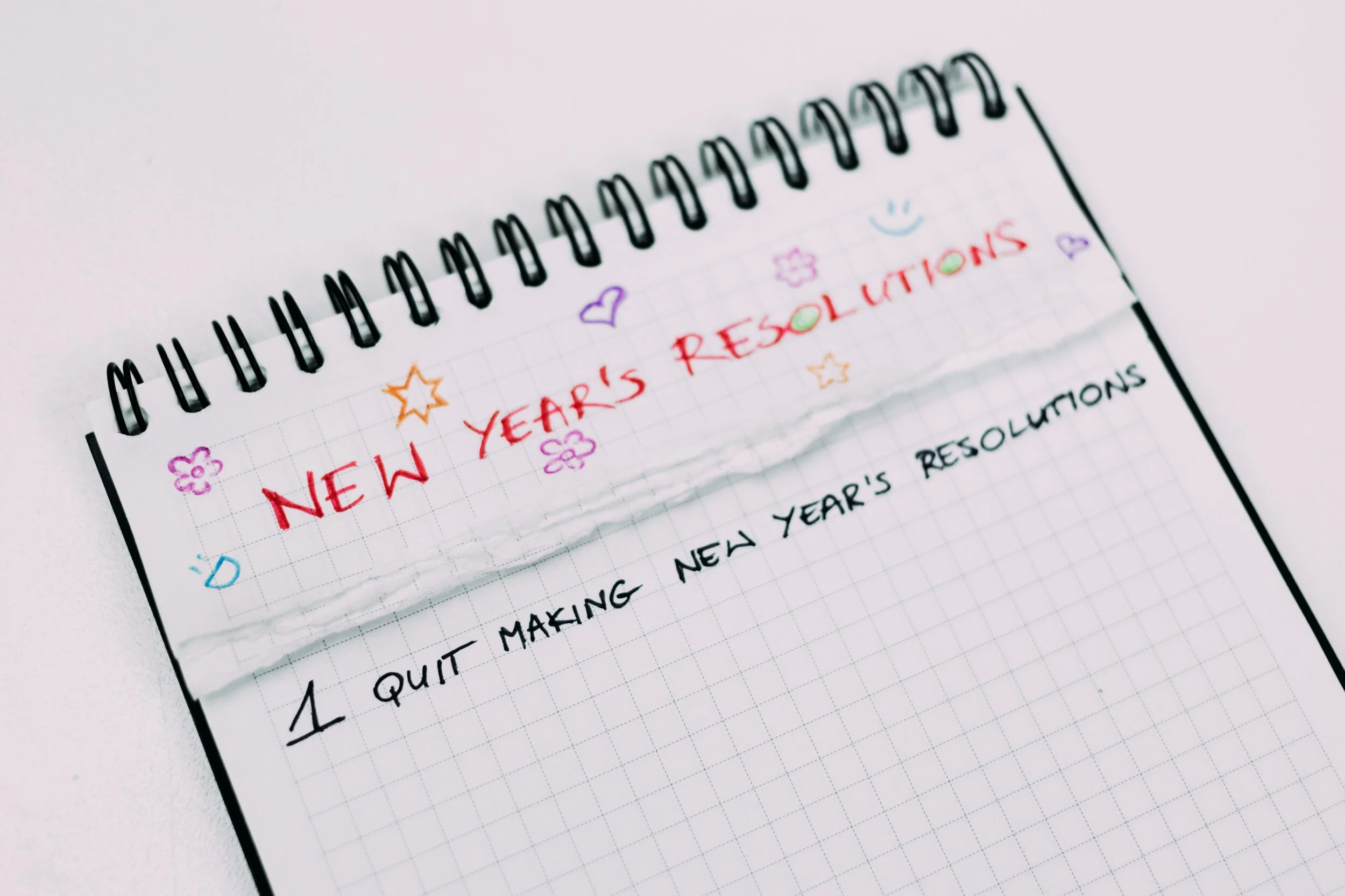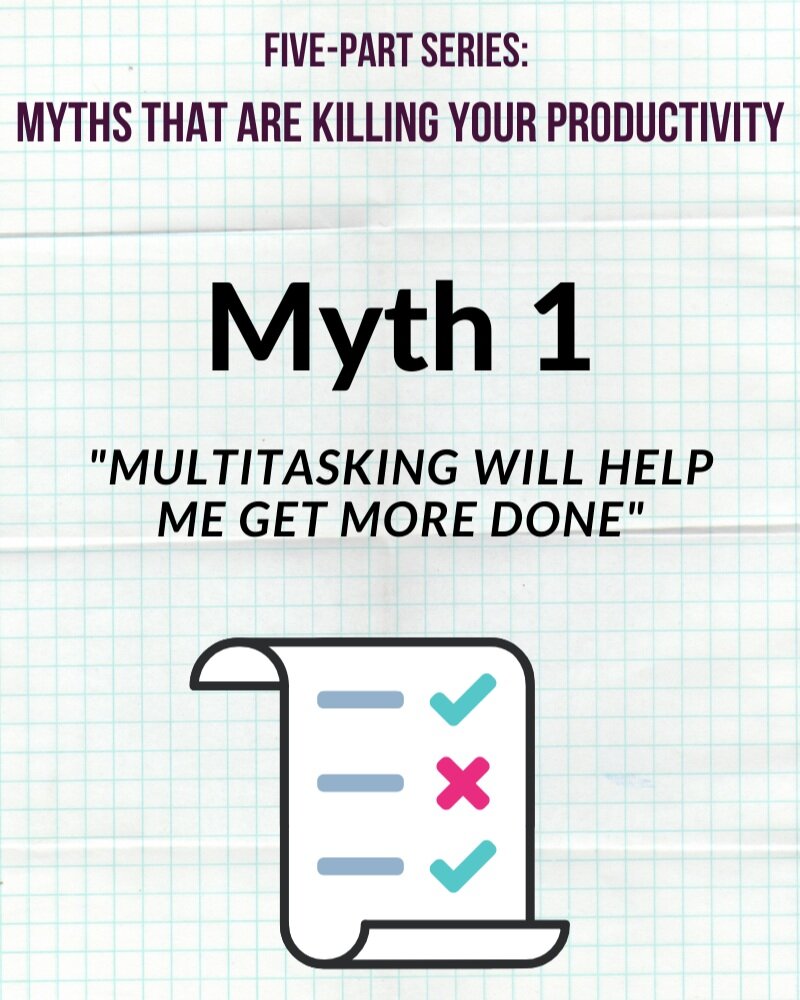A Five-Part Series on the Myths You’re Believing That Are Killing Your Productivity
Introduction
You love those inspirational quotes about productivity and success. You get excited by time management tips and tricks. To-do lists are your jam. You’ve written your daily goals, your weekly goals, hell - you’ve even gone so far as to write your yearly goals. Speaking of yearly goals...
It’s almost the end of 2019 and you are loath to look at that 2019 list of goals because you’re pretty sure you haven’t hit some of the milestones or even remember what you might’ve written down. Instead of feeling disappointed by this past year’s shortcomings, it may feel easier to look towards the year to come and say
“Well, next year…”
Break out the new planners. New lists! New you!
Feel familiar?
What would it be like to set yourself up for success this new year and make concrete progress on important and meaningful goals?
What if I told you that part of setting yourself up for success means you first need to identify what sets you back?
And what if I told you that some of those setbacks are beliefs you’ve held which are negatively impacting your lifestyle choices, productivity, and success?
Such is the case and I’m going to share Five Myths of Productivity across five weeks. These myths of productivity are what most people, including yours truly, buy into that sabotage our paths to success on our most important goals.
Let me channel my inner coach, accountability partner, bad-ass therapist for a minute…
We’re doing a makeover of the habits you thought led to success but are actually
time - energy - productivity suckages
At the end of this post, you can read a sneak peak of what’s to come in the next few weeks.
This five-part series starts this week and will lead us right up to the New Year. Perfect timing, right? See what I did there?
Ready?
Myth 1: You believe multitasking will get you more things done faster.
Truth: Multitasking is a lie.
You are not capable of doing two things at once and doing them both equally well.
It’s rare we can simultaneously do many things without there being some cost to one of these tasks.
While you may be able to walk and talk at the same time, how many of you have you ever been so engrossed in a conversation that you just barely missed the person on the bike that whizzed past you? Or don’t get me started on one of the most egregious forms of multitasking people are guilty of these days which is texting while driving.
You might be thinking: “Yesel, I’m not doing dangerous things when I multi-task. Stop being so dramatic.”
Not only do attempts at “multitasking” impact your safety, they impact your performance and productivity on your important goals. They impact your job, relationships, and mental and emotional health.
I’m going to go out on a limb and say that the incremental attempts at multi-tasking add up to a whole lot. A whole lot of time and mental energy suckage and not a whole lot of quality progress to show for.
If we’re not multi-tasking then what are we doing?
It is more accurate to say you are switching between tasks, or what researchers call “task-switching”. When doing this, performance wanes on both of the tasks at hand.
A research study’s findings on the toll of task-switching
One research study of task-switching found that when students were tasked with classifying geometric objects or solving math problems, the time it took to do either task increased. In other words…
By trying to multitask, their performance got worse.
Why did this happen?
Not only were these two different tasks, the “rules” you had to apply to do either task were fundamentally different. What it takes to classify objects takes a different set of mental “rules” to solve a math problem (“This is a square. This is a triangle” versus “16 divided by 4 equals 4. 25% of 80 is 20”).
Think of it this way…
Imagine if I asked you to write an e-mail to your boss and then mid-e-mail, asked you to switch to changing a diaper for a baby.
What it takes to write an effective email to a boss is very different than what it takes to coordinate your attention to changing a diaper, right? And if you try to move between these tasks, you’re either going to forget some important step in the diaper-changing, or you might have more typos or accidentally write “baby poop” in the email (Let’s just say…).
What the researchers found was that it not only took longer for students to do each of the individual tasks when they had to switch from one to another,
…As the tasks got more complex, their performance suffered even more.
In other words, it’s one thing to try and switch between brushing your teeth and checking your phone messages in the bathroom. The tasks aren’t that complex. Loss in time or performance may not feel significant.
Our multitasking efforts really begin to take a toll when we’re at work or attending to important relationships.
In these situations, we have to use a lot of mental energy, there’s more at stake, and the tasks are more complex.
Multitasking is not all it’s cracked up to be
Research seems to show that task-switching has its costs. But don’t take my word for it.
Recall an experience in your life when your attempt to multitask was more detrimental than productive.
Like that time you were out with your significant other but you both kept checking your phones each time notifications caught your attention?
Meaningful or Meaningless?
So, if I’m not multi-tasking, how am I supposed to get sh*t done? Where do I start?
Introducing the Uni-Tasker
Step 1: Be clear on one task you are working on and focus on this one thing.
What is the one thing I can do first that will give me the biggest bang for my buck?
I have to choose only one thing that I can do today to call it a successful day. What is it?
Choose the one thing that even if that’s the only thing you get done today, you would still be able to call today a success.
Your #1 priority may be based on a deadline or it may be because it is of most value to you (or both).
Step 2: Identify a barrier that will get in the way of accomplishing your #1 priority
What’s the number one thing that will get in the way of accomplishing my #1 priority?
Figure out a concrete way of preventing that barrier from getting in the way.
For many it’s distractions in the form of e-mail, text messages, or random people popping in and asking you questions. Silence your phone, turn off notifications, close your door and/or tell people you’re AWOL for a period of time.
What happened when I gave up multi-tasking and switched to uni-tasking.
When I first began adopting uni-tasking and identifying my #1 priority for the day, I was surprised by how much simpler things became. This level of focus helped me cut out a ton of noise and I noticed I could get that one thing done much sooner than if I’d tried to do it while switching between other things.
Simpler but not easy.
However, I did feel nervous about “all the other things” that I felt were waiting to be done and vying for my attention. It was an adjustment and took trial and error to trust this process of doing one thing and one thing only.
I’ve come to understand that when you choose to tackle one thing at a time, you will inevitably be putting others on hold.
Get used to it. Let them wait in line.
You will get to them and when you do, you will again knock them out more efficiently than had you switched back and forth between items.
So, set realistic expectations for when your tasks need to get done and decide the order of priority.
Conclusion
Multitasking is a lie. You are not in fact doing multiple things at the same time. You are switching between tasks and your energy and performance get worse when you do that.
Skeptical? Multitasking is tempting because there are a lot of messages about how multi-tasking will yield maximum productivity and results, or that juggling multiple things on your plate somehow makes you more of a superstar. If you still think this, then go back to the beginning and re-read or read the references at the bottom of this post.
Uni-tasking, or doing one thing at a time, in order of priority, is the key to getting things done. And not just done, but done better than you would have if you’d tried to multi-task. And not just any things, but the important things you want to accomplish.
The most important thing is that you take one step towards building this new habit and be open to what happens next...
Sneak Peak of What’s to Come:
Myth 1 - Multitasking will get more things done faster
Myth 2 - My goal is too hard so I better quit while the going is good.
Myth 3 - Saying no will limit me so it’s better to say yes
Myth 4 - Self-care can wait
Myth 5 - I can do this myself
Stay tuned next week!
How will you apply this mindset shift from multi-tasking to uni-tasking today?
What is one thing you’ll do first today?
Leave a comment below!
Do you need help clarifying your priorities? Are the concepts in this article resonating for you but you’re at a loss as to how to implement them and maintain progress? I help people through the clarification process of identifying their values, goals, and action steps towards achieving their meaningful goals. Contact me and I can answer questions you may have about this or about working with me!
References. Read More on Multitasking and Task-Switching
Editorial: Multitasking: Executive Functioning in Dual-Task and Task Switching Situations (Strobach, Wendt, & Janczyk, 2018)
Executive Control of Cognitive Processes in Task Switching (Rubinstein, Meyer, & Evans, 2001)
Multitasking: Switching Costs (American Psychological Association, 2006)
Five Reasons Multitasking Makes You Less Effective - The One Thing Blog






